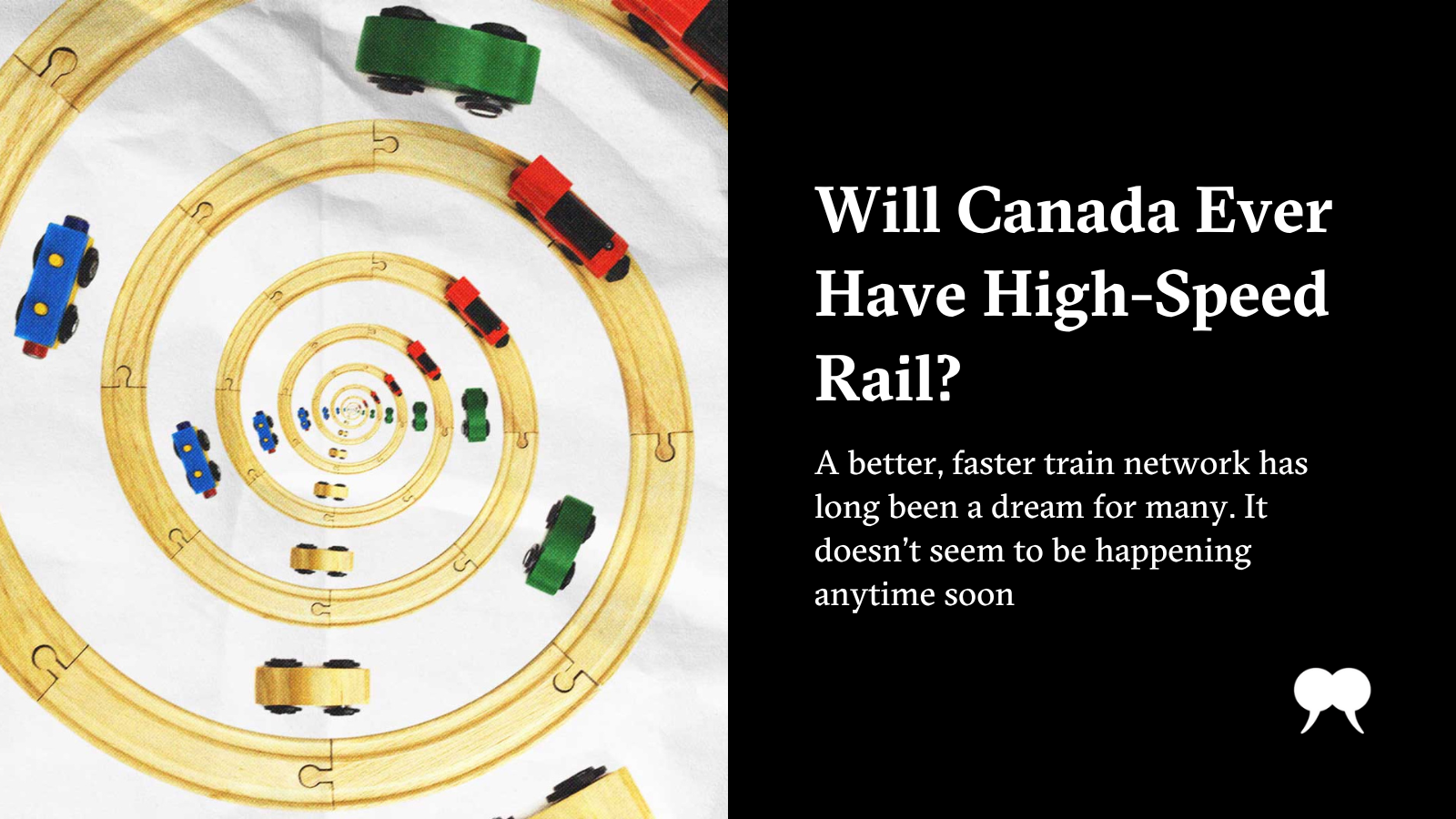I find it strange that Canada could complete the Canada Pacific Railway in 1881 with a population of 4 million and the Trans Canada Highway in 1962 with a population of 18 million but such a national project in 2024 with a population of 40 million is impossible. More like, ever since the funding strategy for infrastructure moved over to the P3 model primarily, infrastructure investments can only happen if a private organization can profit from them in the relatively short term. And this makes the investment costs of such mega projects too high for private interests to want to take on. But no one points at the CPR or the Trans Canada Highway and frets about the costs now. The value of the investments are apparent. They built the country we live in. A trans national hsr network would do the same.
Doesnt even need to be a national network. Just start with the quebec-windsor corridor, where half the country lives.
Hell, just start with montreal to toronto which is like 30% of the country’s population
I agree that this would be okay, but I think a lot of the value in HSR for Canada would be it’s ability to bring the country closer together for more people. Imagine being able to go from Vancouver to Halifax for like 80$ or whatever at speeds comparable to flying. This would open up intra-national travel to a much greater portion of the population and over time help build connection in a country that can be prone to regionalism.
To be honest, it doesn’t have to be HSR at that point. Just reliable normal rail would do that, something we’re still lacking for most of the country. Imagine being able to get to any province in a day under $30 (and even cheaper group deals) with zero chances of any delays.
Vacations across Canada, or even just visiting family in another province for a weekend would be easy and regular. Not to mention how much it would bring the nation together. As things stand, the provinces are more separated from each other than the states in the US. We’re closer to the EU than the US in terms of unity. Arguably even worse than the EU. Promoting cross provincial movement for even little things would seriously bring us together, not to mention all the economic benefits.
We want rail to move people away from population centres
That’s not going to happen.
Chicken and egg problem.
It’s amazing what you can accomplish by exploiting Chinese immigrants to do the most dangerous work for $1/day (half of what white Canadians were paid for less dangerous work) (source).
So building a high performance rail network in the 21st century will cost a lot more, but it will still be worth it.
That of course is a sad fact of our history. However, the productivity of the average worker is also much greater than it was back then. We aren’t exactly laying down large infrastructure projects with gangs of guys using hand tools anymore, or at least not nearly to the same degree. So I think we can keep production costs down (relative to inflationary differences between then and now) minus the racial oppression and awful working conditions.
It’s not a question of productivity now, it’s a question of organization. Our governing institutions are too full of rent seekers and mafias now to do the kinds of things it did post WW2. Nobody can do anything big anymore because the system fights them. We can’t even stop daylight savings time, which basically nobody wants to keep doing
Canada today is almost certainly less corrupt and rent seeking than the literal Gilded Age, when the country was founded! In fact, the Pacific Scandal was our first major political scandal, involving political bribery by railroad investors and leading to the resignation of John A Macdonald.
I really have to push back against this pessimism about government. It only serves conservative pro-privatization interests to push that narrative. The problem is political will. Voters easily approve major new highways in ON. We would get rail if voters demanded it. So let’s start a movement!
Environmental assessments, negotiations with First Nations, land acquisition/expropriations, not to mention that every little town along any proposed route would be pushing for a stop. Throw in assorted loons and NIMBYS and their legal efforts, and it’s a wonder anything ever gets built. The fact that there are more people makes it much more difficult, not easier.
The initial transcontinental railways were very much a partnership between business and government. And a hugely corrupt one at that.
The Trans Mountain pipeline just going from Alberta to BC port is running at $30B currently. Much of that is due to opposition from locals and their legal efforts and protests. It’s a hugely easier construction/engineering effort to put in a pipeline than an HSR line. Grades aren’t important, a ditch is dug and the line is plopped in then covered. They’re deep enough and flexible enough that most heaving won’t affect it. Throw in some booster stations and Bob’s-your-uncle.
HSR tracks have to be near perfect to ensure stability and there are tight limits on allowable grades/radius etc. Just the route surveys would be a huge challenge.
I like how the article states that high speed rail is nearly impossible on the basis that the company doesn’t own the tracks. High speed rail should be built on its own dedicated track, which is expensive but so are the massive highways we have built.
Once the rail is built, minimum density and mixed zoning could be enforced near the stations, which would promote ridership and create transit oriented neighbourhoods instead of the standard car centric neighbourhood.
Municipalities that are skipped by the rail could be serviced by good quality bus rapid transit to get people to their nearest stations. The stations themseleves and the overall process of boarding trains in Canada should be streamlined as well to make ticketing, boarding, and baggage more effecient and faster than the current airline style treatment.
Or serviced with regional rail instead of bus.
Porque no los dos
That implies forethought and planning on behalf of governments at all three levels. And moreover, for them to do it together.
Canada - it’s a like the US, but with a public health system and worse cronyism
Probably not in my lifetime…
Population density requirements need to be met first. Ironically, the massive immigration numbers everyone is complaining about is the only way in the long term, given our fertility rates.
This of course is also predicted on housing availability but that is another issue.
There was a plan for this once upon a time. https://en.wikipedia.org/wiki/Mid-Canada_Corridor
Today there are also land use rights issues.
Immigration means fuck all if we still only build low density single family homes. The only thing that increases density is zoning and building for density.
Just replace the 401/A20 with a HSR line already.
Boohoo, Ottawa matters; fine, sacrafice the 416/417 too.
HSR is 3x the cost of conventional passenger rail. HSR also doesn’t get freight revenue to help defray costs, the traditional way NA passenger rail routes were supported. All revenue is either through ticket sales or government subsidies.
Compounding that, conventional passenger rail hasn’t been profitable since at least the 1950s, one of the reasons both CP and CN were all too eager to pawn off their passenger rolling stock to VIA in the early 70s.
Over the last 3 years, the French rail company SNCF has needed a €35B injection from the government to remain solvent and cover ongoing expenses. This is above existing subsidies.
The German rail company is in similar shape. Deutsche Bahn estimates that it needs €14B for infrastructure upgrades. Their ‘on time’ performance is now down to 75%, which is very low for them.
In China, an estimated 90% of their HSR routes are unprofitable. It is unclear how far the central government will go to prop up these routes.
It always boils down to “speed costs, how fast can you afford to go?” It’s also not a linear relationship.
If you’re worried about cost: car infrastructure is the most expensive per capita. Unlike public transportation, roads are almost entirely government subsidized, with virtually no tolls or pay roads anywhere in the country. The worst part of subsidized highways are the spillover costs: oceans of subsidized parking lots and wide subsidized roads to service all the cars. In most NA cities, 60% of surface area is devoted to cars. What a waste.
That’s not counting the private costs, which people massively underestimate. Cars cost an average of $14k a year. This is why Canadians and Americans spend more on transportation than almost any country in the world.
And what do we get for all that extra cost? A lower quality of life: The longest commute times in the world, amongst the highest traffic deaths in the developed world (which is the biggest killer of children in Canada), a housing crisis due to low density, obesity and cardiovascular disease due to lack of incidental exercise, and high property taxes to maintain all that inefficient asphalt.
Canadians are also amongst the highest per capita carbon emitters, in large part due to tailpipe emissions and car centric urban design.
It’s not just cars, now is it? Thirty percent of all freight in NA is carried by truck (compared to 70% in Europe). If we focus in on “last mile” it’s near 100%. Also, depending on jurisdiction, the gas tax and licensing fees pay for the road infrastructure. If you don’t have a car, you’re not contributing.
That’s why the costs of road infrastructure were initially tolerated, with personal use secondary. Once people got used to the freedom, and car ownership exploded, road works were emphasized.
Having said that, HSR, does nothing for commute times. That’s the domain of buses, light rail, trams, subways and conventional rail. All of which have been neglected, but that’s a separate issue. HSR is also energy intensive, as energy required to move an object is proportional to the square of velocity.
The tracks have to be pretty much prefect to maintain stability. Given the amount of frost heaving we get, that 3x the cost of conventional rail might be extremely optimistic. Sections of track in Sweden, for instance, have been reduced from 200km/h, very much the lower limit of what constitutes HSR, to 130km/h, not far off the current speeds here on some sections, due to track deterioration.
I would like to see all rail infrastructure owned by a crown corp, with private rail companies competing with their own rolling stock, both freight and passenger. They’d pay the crown corp for track/station use, with those funds paying for maintenance and upgrades. That move would greatly improve the rail situation here.
As far as HSR, it an expensive boondoggle waiting to happen.
But good rail reduces the dependance on car infrastructure. Less lanes to maintain, less traffic means less wear of the road. Transit doesn’t need to be profitiable itself to still be worthwhile. It can bring value in other ways like increasing land value near stations, reducing car traffic and emissions, providing social, cultural and business connections.
Most highways and roads cost more to maintain than they bring in revenue as well.
Regular, reliable rail makes sense. It’s much cheaper to build, cheaper to maintain and the rolling stock is cheaper too. There’s also the energy demand, it increases in proportion to the square of velocity. HSR is just too expensive for the limited benefits.
Almost all of the wear on our roads is from truck traffic, with one maxxed out tractor trailer equaling the wear caused by roughly 10,000 personal vehicles. HSR does nothing to alleviate that.
Rail has to be competitive with cars to maintain and encourage ridership. High speed rail can offer significantly faster travel times than cars.
The time to build regular reliable rail was decades ago, we should strive to build more modern technology that will serve us longer into the future and encourage people to switch from driving by being faster. HSR can still be reliable so long as maintaince is properly funded.




